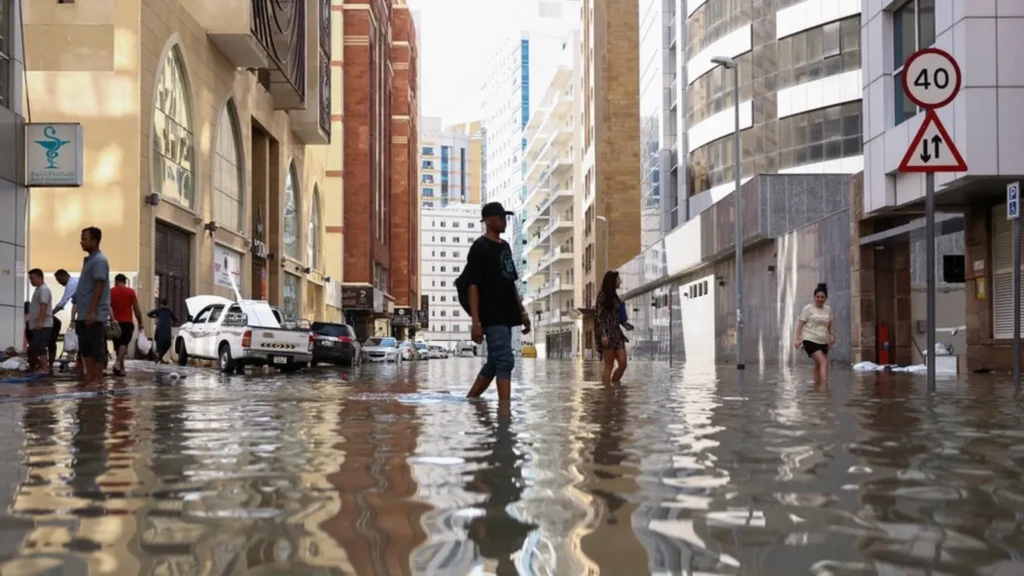In recent years, Dubai has experienced some extreme weather events, one of the most notable being the flash floods that hit parts of the city. These events have sparked discussions around weather modification techniques, particularly cloud seeding, and whether it could have been responsible for the unexpected flooding. While the idea of controlling the weather is intriguing, it’s essential to understand what cloud seeding is, how it works, and whether it could be linked to such events.
What is Cloud Seeding?
Cloud seeding is a weather modification technique that aims to enhance precipitation, typically in the form of rain or snow. This process involves introducing substances into clouds to encourage the formation of larger water droplets, which eventually fall to the ground as rain. The most common materials used for cloud seeding are silver iodide, sodium chloride (salt), and potassium iodide.
Cloud seeding is primarily used in regions that experience dry weather, such as parts of the UAE, to increase rainfall and improve water supplies. The goal is to increase precipitation in areas facing droughts, reduce the impact of heatwaves, or improve water availability for agricultural and urban needs. It is also sometimes used in the context of reducing the severity of storms, though its effectiveness in that area is still debated.


How Does Cloud Seeding Work?
The process of cloud seeding typically involves aircraft or ground-based generators releasing seeding agents into the clouds. These agents act as nuclei, or “seeds,” around which water droplets can form. Once the droplets grow large enough, they fall to the ground as rain. The process relies on the presence of moisture in the clouds, and the effectiveness of cloud seeding can vary depending on factors such as cloud conditions, temperature, and the type of seeding agent used.
Cloud seeding is generally carried out when weather conditions are right, with forecasters and meteorologists identifying the optimal times to intervene. It is not an exact science, and its results are not guaranteed. While cloud seeding can increase the likelihood of rainfall, it is important to note that it is not a method for creating storms or inducing flooding. The amount of precipitation is usually modest, although the exact results can vary.

Dubai and Cloud Seeding: The UAE’s Investment in Weather Modification
In the UAE, cloud seeding has been used for several years as part of the country’s efforts to combat water scarcity. The UAE’s National Center of Meteorology (NCM) has led the charge in cloud seeding, investing in technology and equipment to increase the region’s annual rainfall. The UAE is one of the leading nations in the field of weather modification, using a combination of aircraft, ground-based generators, and sophisticated weather radar systems to carry out cloud seeding operations.
In addition to increasing rainfall, cloud seeding has also been utilized to reduce the effects of extreme weather patterns, such as heatwaves or dust storms, by generating localized rain showers. The UAE government has actively pursued weather modification as a tool to mitigate the impacts of climate change and ensure a steady supply of freshwater.
Did Cloud Seeding Cause the Dubai Flooding?
When flash floods occurred in parts of Dubai in early 2025, many residents and observers speculated that cloud seeding might have played a role in exacerbating the heavy rainfall. However, it’s important to clarify that cloud seeding itself does not cause flooding.
Flooding is the result of excessive rainfall, usually when the ground is already saturated, or when the drainage systems cannot handle the volume of water. Flash floods can occur rapidly and with little warning, especially in areas with steep terrain or poor drainage infrastructure. While cloud seeding can enhance rainfall in targeted areas, it is unlikely to cause the intensity of rainfall required to result in a flood unless other weather conditions—such as an existing storm or atmospheric instability—are also present.
In Dubai’s case, the flash floods that occurred were likely due to a combination of factors, including intense rainfall from a developing storm system, the timing of the rainfall, and the region’s infrastructure’s ability to manage such an event. While cloud seeding could have contributed to the rainfall, it is unlikely that it alone was responsible for the severity of the flooding.
Understanding the Role of Cloud Seeding in Precipitation
It is also important to note that cloud seeding is typically used to enhance natural rainfall in a controlled manner. The amount of rain generated through cloud seeding is generally modest—usually, only a few millimeters per event—and it is unlikely to result in the kind of large-scale, catastrophic flooding that can occur with extreme weather systems. In contrast, flash floods are typically caused by the sheer volume of rain that falls in a short period of time, often from weather systems that have developed naturally, such as monsoon rains or low-pressure systems.
While cloud seeding can help to increase rainfall, it is not a technique that directly influences the intensity or speed of rainfall. Additionally, the UAE’s cloud seeding program has been in operation for years, and it has never been linked to causing widespread flooding in the region. In fact, the primary goal of cloud seeding in the UAE is to increase water availability for agricultural and municipal needs, not to induce extreme weather events.
Conclusion: Cloud Seeding and the Reality of Flooding in Dubai
The occurrence of flooding in Dubai was likely the result of extreme weather conditions that were far beyond the control of cloud seeding efforts. While cloud seeding can enhance rainfall, its impact on the overall weather is relatively modest and does not have the power to create destructive storms or induce large-scale flooding on its own. Flash floods are typically caused by intense weather systems, and while cloud seeding may have played a minor role in increasing precipitation, it is not to blame for the flooding.
Cloud seeding remains a valuable tool for improving water resources in arid regions like the UAE, but it is important to separate fact from speculation when considering its role in weather events like flooding. The flooding in Dubai was likely due to a combination of factors, including a natural weather system and the limitations of the city’s infrastructure to handle the intense rainfall, rather than the result of deliberate weather manipulation.
Do follow Uae stories for more Updates
Landmark Jebel Ali: A Hub of Growth and Connectivity in Dubai














